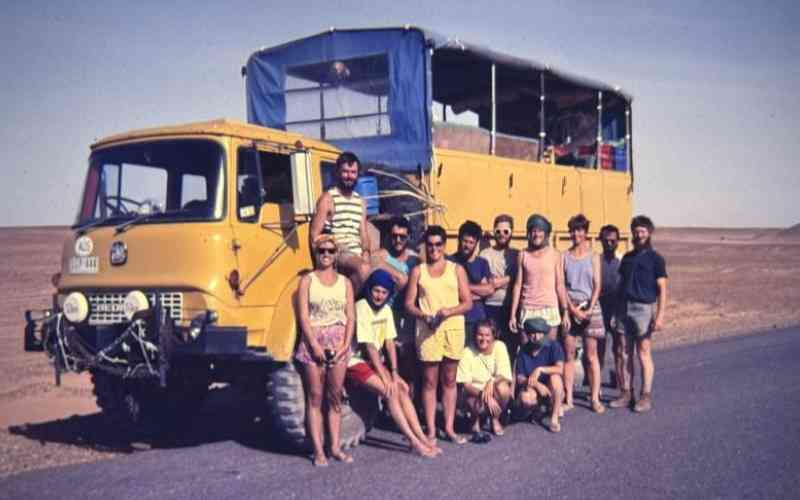
The year is 1988. Two men in their late 20s, Darrell Wade and his college-mate, Geoff ‘Manch’ Manchester from Melbourne, Australia, craft what they think is the best idea of fun.
With Wade taking the lead, they buy a former council truck and retrofit it to suit an overland adventure, ship it to England (while they fly there), drive the truck through Europe and into Morocco before traversing some of Africa’s volatile regions in the good company of “friends, supplies, a handful of aviator sunglasses and a case or two of beer”.
Seven months later, in October of that year, the team arrives in Nairobi where the luxuriant Jacaranda trees are in full bloom. Hurray! Mission accomplished. But was there any other plan beyond having a good time in Nairobi?
“Okay, we were young and just wanted to have fun,” Wade confesses during our meeting in Gigiri Nairobi. “I knew I wanted to be in the travel business. But how to run it? None of us on that trip had any idea.”
But first, Wade and his friend had to rake in some coins in what was then truly the ‘green city under the sun”.
“We sold the truck in Nairobi,” says Wade. “It was quite profitable 36 years ago.”
Having grown up as friends, Wade and Manch knew each other’s adventurous spirit for 13 years before the epic trip. Wade seems to have been born to travel, having accompanied his father on business trips abroad from the tender age of six.
Still, the idea of how they would advance their adventurous spirit beyond the African trip kept ringing in their minds.
Then they talked and talked some more. Could they make a living organising such trips to different parts of the world? Did they have what it took to run a profitable travel business?
Before the African trip, Wade had worked in several hustles, but knew nothing about travel, neither did his childhood buddy, Manch, a good thing because “we had no blinkers on and had to learn on the go”.
The duo went back home where Wade told his then-girlfriend (now wife Anna) about all the nice conversations they had in Africa.
“Talk is cheap, but what are you going to do?” she asked.
Anna has always been the voice of reason and was an honest sounding board to Wade’s ideas. She had previously shot down some “that seemed to have no legs” including one on importing an American plane.
But she liked the idea of an adventure outfit. Intrepid Travel was born the following year and arranged itineraries for 46 tourists by the first year.
Today, Intrepid curates over 2,500 itineraries in 120 countries, making it the world’s largest ‘B’ Corporation adventure travel company that practices low-impact experiences.
“Our start was no light bulb moment,” says Wade, who served as the company’s chief executive officer for 20 years and then, as chairman since 2017.
As they rode through the blinding sands of the Sahara in 1988, Wade and Manch may not have envisioned what a behemoth their future creation would become.
The 35-year-old adventure company needs to be fed with a constant supply of visitors, sustainable itineraries and more visitors. In fact, Wade’s recent visit to Nairobi was to explore ways of adding the accommodation aspect to the growing portfolio and double its global customers and achieve revenues of over a billion dollars.
That will be an incredible achievement and music to the ears of the travel sector in East Africa and Australia.
“East Africa is home to a rich biodiversity and culture,” says Wade. “Through sustainable travel practices, visitors engage with East Africa’s natural wonders responsibly, leaving a positive footprint for generations to come.”
Wade is a champion for sustainable travel who, paradoxically, has had a love-hate relationship with the industry.
“Why stay in wonderful places, but put a traveller in a cocoon?” He answers his own question with another question: “Why fly from London to Nairobi only to stay in a hotel for two nights just like you would have in London without meaningful immersion in local culture? There should be a bridge between tourism and local culture. Destination is not just ‘pool and cocktails’, but about people.”
But the greatest enemy to tourism is the industry’s inaction towards mitigating the effects of climate change. The industry has grown to encompass 10 per cent of the world’s GDP and bringing with it immense carbon emissions.
“At Intrepid, we have a plan to reduce customer emissions per passenger per day by 55 per cent by 2035 in line with Paris Accord,” says Wade.
“What if we fail”? I ask him.
“Two things will happen,” he says. “One, our destinations will be less viable. Sea levels will rise, and beaches will disappear. Temperatures will rise and snows will disappear, affecting skiing. Cities will flood constantly. Deserts will encroach and destroy national parks especially in Africa, impacting the industry and hence less places to travel. Second, travel industry will be a pariah like the smoking industry. People will shy away from investing in tourism.”
Sounds like an apocalyptic script. But it can be revised by changing travel behaviour.
“In Scandinavia, people look down on you if you fly rather than take the train or drive your vehicle. Driving is the best way to see a country, visiting villages and interacting with locals. In Kenya, you have many places to visit sustainably. The national parks, the Lake Victoria region, and Mount Kenya area with interesting stops along the way,” says Wade.
Wade still travels like a backpacker, has been to more than 100 countries, but has difficulties pinning his favourite destination. “The world is a beautiful place.”